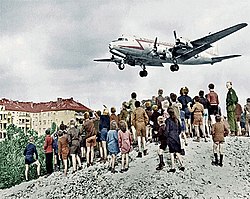| 48th Airlift Squadron | |
|---|---|
 48th Airlift Squadron C-130J-30 Hercules | |
| Active | 1942–1945; 1946–1949; 1953–1955; 1964–1967; 1971–1973; 2003–2018 |
| Country | |
| Branch | |
| Role | Airlift Training |
| Part of | Air Education and Training Command |
| Garrison/HQ | Little Rock Air Force Base |
| Engagements | Mediterranean Theater European Theater [1] |
| Decorations | Distinguished Unit Citation Air Force Outstanding Unit Award [1] |
| Insignia | |
| 48th Airlift Squadron emblem (approved 30 August 1954) [1] |  |
The 48th Airlift Squadron was part of the 314th Airlift Wing at Little Rock Air Force Base, Arkansas. It operates Lockheed Martin C-130J Super Hercules aircraft, conducting pilot and loadmaster training for airlift and airdrop operations.
Contents
- History
- World War II
- Berlin Airlift
- Tactical Air Command
- Air Education and Training Command
- Decorations
- Lineage
- Assignments
- Stations
- Aircraft
- References
- Notes
- Bibliography
- External links
The squadron was first activated as the 48th Transport Squadron in June 1942. As the 48th Troop Carrier Squadron, it flew Douglas C-47 Skytrains in the Mediterranean Theater of Operations during World War II, earning Distinguished Unit Citations for carrying reinforcements to Sicily despite fire from ground and naval forces in July 1943, and for participation in Operation Overlord in June 1944. It converted to Curtiss C-46 Commandos, with which it took part in Operation Varsity. After V-E Day, the squadron returned to the United States, where it was inactivated.
The squadron was activated in Austria in 1946, but in 1947 was transferred to the United States on paper and began to train with Fairchild C-82 Packets. The following year, the 47th returned to Europe to participate in the Berlin Airlift with Douglas C-54 Skymasters. After the successful completion of the airlift, the squadron was again inactivated in 1949. The squadron was briefly active from 1953 to 1955 at Mitchel Air Force Base, New York and Sewart Air Force Base, Tennessee as a Fairchild C-119 Flying Boxcar unit.




